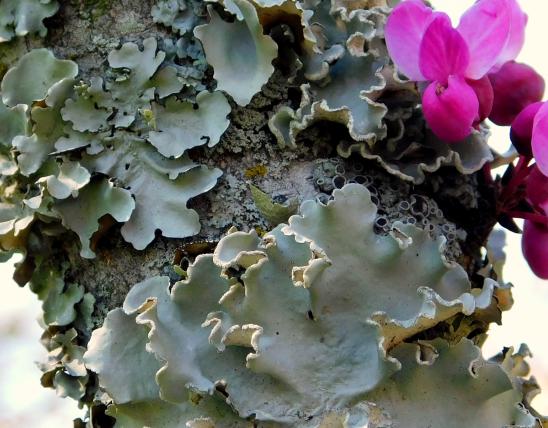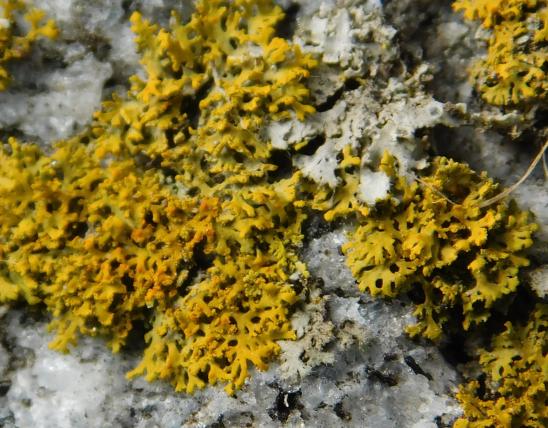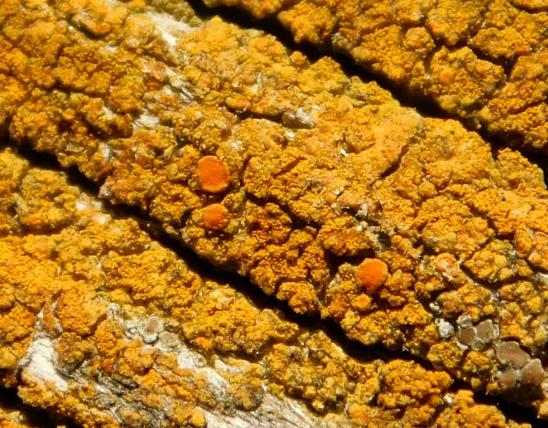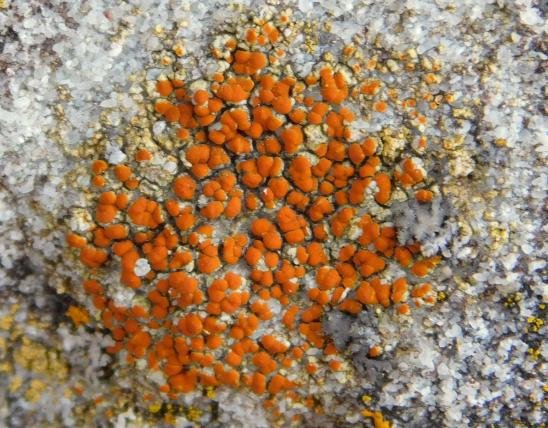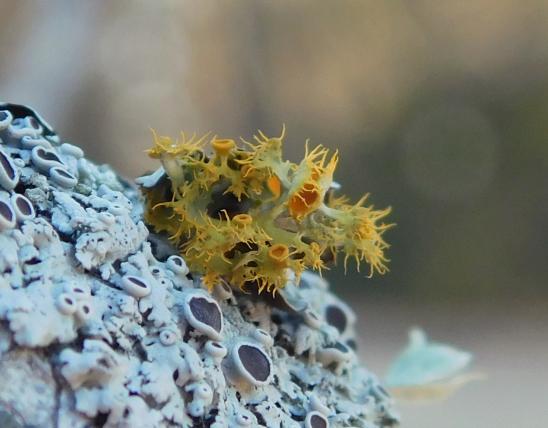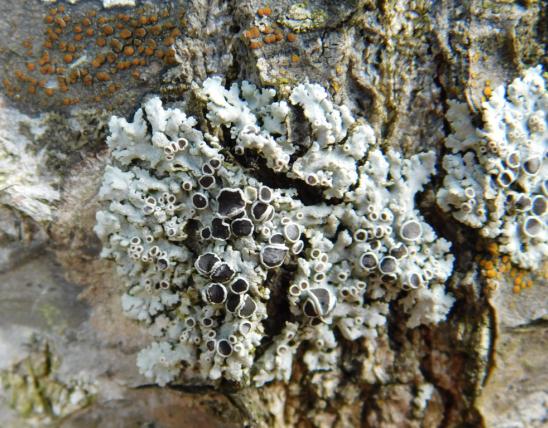
Candleflame lichens (Candelaria spp.) are tiny to small, greenish-yellow to mustard-colored foliose lichens that grow in a branching, rosette form. Use a hand lens, or a camera that takes good closeups, to see the delicate, small, branching lobes. Globally, there are about 11 (or 4) species (lichenologists are reorganizing the group); 2 species are recorded for Missouri; both typically live on bark of tree trunks.
- The lemon lichen (Candelaria concolor), widespread on our continent, is very small, at most only about the size of a fingernail, although it often grows in groups covering large areas on the bark of trees, in sunny areas. Ash, walnut, elm, and maple are preferred. The undersurface of this lichen is whitish. This species rarely forms disk-shaped apothecia (spore-producing structures); however, numerous granular or fluffy-looking soredia (pieces of the lichen that break away to become new lichens) form at the outer tips, making it look frilly-edged. Sometimes the soredia cover nearly all the lichen’s surface. One variety of this species (var. effusa) is composed almost entirely of the soredia, making it look crustose instead of foliose.
- A close relative, C. fibrosa, has disk-shaped apothecia instead of soredia. It, too, is called candleflame or lemon lichen.
Like other foliose lichens, candleflame lichens are lobed, frilly, or leafy, somewhat like foliage. The lower surface of foliose lichens is usually a different color than the top surface.
A lichen is an organism that results when a fungus species and an algae species join together. Although the relationship between the fungi and algae is quite intimate and integrated, the lichen that is formed does not much resemble either of the components. Learn more about lichens on their group page.
Similar species: The bright yellow color of several lichens makes them seem like lookalikes. Remember that candleflame lichens are a lemon yellow (that is, a greenish yellow) to mustard yellow, and not orange. Also remember that lichenologists apply chemicals to lichens to help verify identifications.
- Orange sunburst lichens (Xanthoria or Xanthomendoza species) can be very common on sunny rocks and tombstones. They are typically orangish or yellow orange, and not greenish yellow. They have a circular, foliose growth pattern with tiny, branching lobes, but this pattern often becomes obscured when these lichens coalesce into large masses of tiny scale-like fragments and portions break off.
- Firedot lichens (Caloplaca spp.) are crustose lichens that attach tightly to their substrate. They have no lower surface. They are usually orange, yellow, rusty, or brown and look like little dots on a surface. Typically grow on rocks instead of tree trunks.
- Goldspeck lichens (Candelariella spp.) are orange-yellow crustose lichens that are frequently seen growing on rock outcrops, tombstones, and other rocky substrates.
Lichens begin as tiny spots but may grow to cover several square inches. A single rosette of candleflame lichen may be no larger than a fingernail. But groups of these lichens may coalesce to cover rather large areas, several inches in length or diameter.
Statewide.
Habitat and Conservation
Missouri’s candleflame lichens are usually found on tree bark, especially that of ash, walnut, elm, and maple. The preferred bark is soft, rough, and starting to decompose (as opposed to tight, hard, smooth bark). Oak is generally not preferred. C. concolor has also been recorded on rocks, including limestone.
Candleflame lichens can be a sign of a high-nutrient (nitrogen) environment. Also, they are rather tolerant of pollution, so this is a lichen you are more likely to see in cities.
Keep in mind the habitat: knowing a lichen’s habitat preferences can help you identify species.
When your lichen explorations start branching out (pun intended), you’ll learn a lot of fancy new terms. Here are some habitat adjectives to start getting to know:
- The term for lichens that grow on tree bark (as opposed to bare wood) is corticolous (it refers to the cortex, or outer layer of the tree). Candleflame lichens are almost always corticolous.
- The term for lichens that grow on bare wood (with the bark stripped away) is lignicolous (it refers to lignin, a primary component of wood). Candleflame lichens are less commonly lignicolous.
- Lichens that grow on rock are called saxicolous (the prefix saxi- is from the Latin word for “rock”). Candleflame lichens are only occasionally saxicolous.
Status
Even though lichens may cover large areas of trees, they are not parasites and do not damage trees.
The taxonomy of this group of lichens is currently debated, so species names, and species counts, may change.
Life Cycle
Lichens can reproduce sexually (via spores) or vegetatively (asexually).
Sexual reproduction in lichens occurs in much the same manner as other fungi. Special structures called apothecia give off spores, which are created as the result of a fusion of gametes (sperm and ova) that occurs in the apothecial tissues. Apothecia, which species C. fibrosa forms, are disk-shaped, with a yellow rim. They look something like tiny suction cups. When lichens reproduce via spores, only the fungal component is reproduced. The germinating fungal spore must quickly attach to a suitable algal partner, or it perishes.
Soredia, which species C. concolor forms, are tiny ball-like packets of fungus and algae that form under the surface (cortex), then erupt from breaks in the upper cortex, rather like tiny pimples. The tiny pimple-like breaks in the cortex are called soralia. Patches where clusters of soredia are forming make the surface of a lichen look rough and dry: fluffy, grainy, or mealy.
Human Connections
There’s a good chance that even if you grew up amid nature, you still may not have ever “seen” candleflame lichens. It’s easy to overlook them. But when you finally take a close look at one of these tiny, delicate, lemon-yellow rosettes, you will be impressed by its fragile beauty.
Ecosystem Connections
Candleflame lichens, being tolerant of pollution, can often survive in cities. Many other lichens, however, are very sensitive to pollution. In places where acid rain occurred before the federal Clean Air Act had started to take effect, many lichen populations declined. This caused ripple effects with other species, such as birds that decorate their nests with lichens. Without the lichen camouflage, the birds’ nesting success was reduced, and the bird populations declined. The Clean Air Act cleaned the air and reduced the acid rain, the lichens returned, and the bird populations rose again, too.
When candleflame lichens are abundant and other lichens are scarce, it can be a sign of pollution.




Mosses, liverworts, hornworts, and lichens seem rather similar, but these organisms are in very different groups. Mosses, liverworts, and hornworts are small, low plants usually found in damp habitats. Unlike more familiar plants, they lack veinlike structures and do not produce flowers or seeds — instead, they produce spores. Meanwhile, lichens are not plants at all: they are a collection of different fungi that have photosynthetic algae living within their tissues.






















